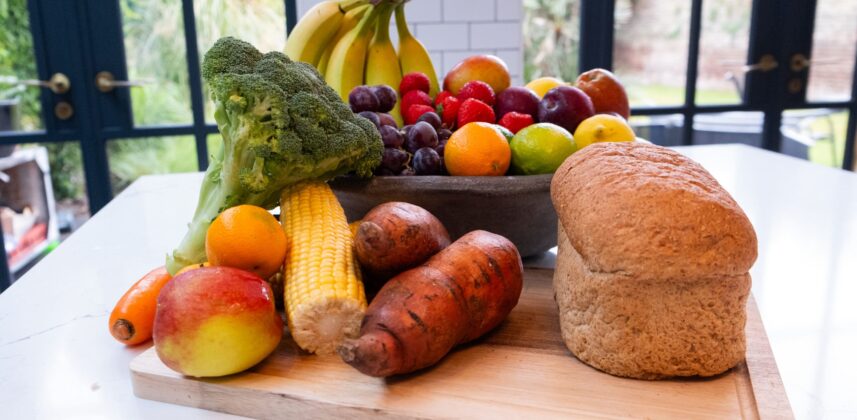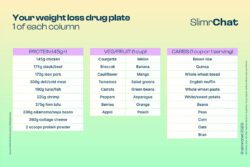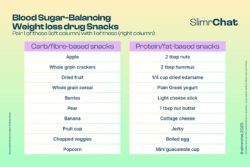Macronutrients 101: Protein, fibre, carbs and fat – what really matters
Anna-Louise Dearden | Last update: 10th September 2025
If you’re using weight loss drugs like Mounjaro or Wegovy, getting your food right can make a big difference to your results, and how you feel. But good nutrition isn’t just about eating less. It’s about eating better. And that starts with understanding macronutrients: protein, fibre, carbohydrates, and fat. This guide breaks down what each one does, why it matters on your weight loss journey and how to balance your meals for long-term health – whether you’re on medication or not

TL;DR Summary
- Macronutrients = protein, fibre, carbs and fats
- All four are essential for energy, fullness and weight loss
- Protein is especially important for muscle and appetite – aim for 45 g per meal
- Use the 3-3-3 rule or balanced plate method to plan meals
- Start small – one meal at a time
Why macronutrients matter for weight loss (and after)
Macronutrients are the nutrients your body needs in large amounts to function properly. They’re the building blocks of every meal:
- Protein helps build and protect muscle, keeps you feeling full, and supports fat loss.
- Fibre aids digestion, manages blood sugar, and helps you feel satisfied.
- Carbohydrates provide essential energy for your brain and body.
- Fats support hormone production, help absorb vitamins, and also promote fullness.
The key isn’t cutting any one of them out, but learning to balance them. A well-balanced plate keeps you nourished, reduces cravings, and helps prevent the “bounce back” once you stop medication.
Protein: The muscle keeper and hunger tamer
Why it’s important:
When you’re losing weight, especially on GLP-1 weight loss drugs, your body may lose muscle as well as fat. Protein helps protect muscle mass, boosts metabolism, and keeps you full for longer. It also plays a key role in maintaining weight loss after stopping medication.
How much do you need?
SlimrChat recommends 1.6 to 2.2 g of protein per kilogram of target body weight per day when you’re losing weight.
Target body weight is based on a BMI of 24.9 (the upper limit of the healthy range). Here’s what that means for the average UK adult:
- Women (1.62 m avg. height): Target weight ≈ 65 kg → 105 to 144 g protein/day
- Men (1.75 m avg. height): Target weight ≈ 77 kg → 124 to 169 g protein/day
This works out to roughly:
- Women: 35–48 g protein per main meal
- Men: 41–56 g protein per main meal
A simple, mid-range target that works for most adults is ∼45 g of protein per main meal.
This is significantly more than the outdated 100 g/day blanket advice and is especially important when aiming to preserve muscle while losing fat.
Good sources of protein:
- Chicken, turkey, lean beef
- Eggs
- Greek yoghurt, cottage cheese
- Tofu, tempeh
- Lentils, beans
- Protein shakes or bars (look for low-sugar)
Tip: Struggling to eat enough protein? Include a protein source in every meal and snack, and consider tracking it for a week to learn what works for you. Here’s a quick guide to sources of protein that don’t need much prep:

Fibre: The secret weapon for digestion and appetite
Why it’s important:
Fibre supports digestion, gut health, and blood sugar control. These are all key when using weight loss drugs. It helps you feel fuller for longer and keeps things moving smoothly.
How much do you need?
Adults should aim for 25-30 g of fibre per day. Many people get far less.
Good sources of fibre:
- Vegetables: broccoli, carrots, leafy greens
- Fruits: berries, apples, pears (with skin)
- Whole grains: oats, quinoa, brown rice
- Legumes: lentils, chickpeas, kidney beans
- Nuts and seeds: chia, flax, almonds
Quick win: Add a tablespoon of chia seeds or ground flaxseed to your yoghurt or smoothie.

We know it’s difficult to get the right intake of macronutrients when your appetite has gone but here is a helpful guide of how to get that fibre and protein intake up even when you don’t feel like it:

Carbohydrates: your body’s fuel source
Why it’s important:
Despite the bad press, carbs provide essential energy, especially for brain function, daily movement, and exercise. When your appetite is reduced on medication, you may under-eat carbs and feel sluggish.
Good vs bad carbs:
- Choose more: whole grains, vegetables, fruit, legumes
- Limit: white bread, sweets, sugary cereals, ultra-processed snacks
How to balance:
Aim for about 1/4 of your plate to be complex carbohydrates. This supports energy without spiking blood sugar.
Fats: don’t fear the fat
Why it’s important:
Fat is essential for hormone regulation, brain health, and absorbing vitamins like A, D, E, and K. Including fat in meals also helps you feel satisfied and less likely to snack unnecessarily.
Healthy fats to include:
- Olive oil
- Avocados
- Nuts and seeds
- Oily fish like salmon and mackerel
Fats to limit:
- Trans fats (in some fried or processed foods)
- Excess saturated fat (in high-fat meats, full-fat cheese)
The “3-3-3” Rule: a simple meal planning trick
If in doubt, try the 3-3-3 Rule:
- 3 meals per day
- 3 key components per plate: Protein + Fibre (from veg or whole grains) + Healthy Fat
- 3 hours apart to keep energy steady and hunger managed
This rule keeps your meals structured and balanced without needing to track every gram.
How to build a balanced plate
As a ‘ready reckoner’ to build your healthy meal plate – check out the infographic below; select one from each column:

Remember: A balanced plate keeps you fuller, longer and supports weight loss the right way.
What about snacks?
Smart snacks keep energy and blood sugar steady between meals.
Good snack ideas:
- Protein yoghurt + berries
- Apple slices + peanut butter
- Boiled egg + oatcakes
- Hummus + veg sticks
- Protein bar (low sugar)
Here’s a great way to balance your snacks to ensure you maintain your blood sugar balance:

Final thoughts: Start small, stay consistent
You don’t have to be perfect but understanding macronutrients helps you build better habits, meal by meal. If you’re using weight loss medication, this balance can help reduce side effects, improve your results and make it easier to maintain a healthy weight when the medication stops.
DaveG, SlimrChat member, “I really struggled with my appetite and as a result I wasn’t getting the right intake of nutrients and that meant I was tired, grouchy and my motivation was dwindling. Then after reading about the importance of protein and fibre I rethought my whole approach to meals. In fact I stopped stressing about breakfast, lunch and dinner and started to build protein and fibre heavy snacks. That changed things for me – there was less pressure to have a whole meal and more focus on getting the right intake throughout the day.”